|
This historical research is a complex process using a variety of sources. Information found in one source can lead to searches in other locations. The research process modelled here explains how archival information held in different places is sourced. The detailed information you find will be as individual as the person you are researching. This will develop a rich picture of your chosen veteran. The addition of local community and family records and mementoes further adds to, and verifies, their story. Ethical considerations form an integral part of historical inquiry. You may come across information that evokes a range of emotional responses, information that is surprising or controversial. What you do with this information often requires a range of ethical decisions. The material you are researching contains many acronyms and abbreviations. Resources published by the Australian War Memorial and National Archives of Australia can help. Another guide is Australian Military Abbreviations, Acronyms & Codes, Michael Cecil, 2014. Use the Research journal (.docx 564kB) to save and organise information that you find on your selected First World War veteran. Note the information on copyright provided in the journal. |
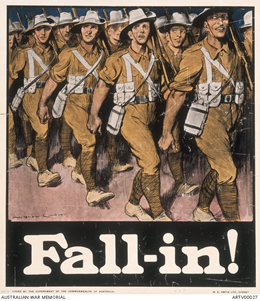 Recruitment poster produced by artist Norman Lindsay. Public domain, Australian War Memorial. |
Who am I going to research and why?
What is already known about this veteran?
|
Strategies to identify an Australian First World War veteran to research include: Schools which date back to before the First World War often have a memorial board listing teachers and students who participated in the First World War. Select a recruit using a family name, or where a local street or place has been named after an early family in the community. View the Register of War Memorials in NSW to see if your memorial is included. If not, you may like to apply for it to be registered as a school community contribution to Centenary commemorations. Clubs hold a list of residents who have participated in armed conflicts. Search Mapping our Anzacs for people who served from your region. Following the war provisions were made for returned soldiers and sailors to be settled in country areas under the Returned Soldiers Settlement Act, 1916. Returned servicemen participating in the scheme were trained in farming practises at Hawkesbury Agricultural College, now part of the University of Western Sydney. View the student cards of returned First World War soldiers. Some of these original settlement blocks now comprise the outer suburbs of Sydney. Be aware that returned servicemen from other countries were included in the soldier settler scheme. Investigating overseas personnel requires alternative research processes to those outlined in this resource. If a local veteran is not possible another option is a NSW public school teacher who served in the First World War. Find a name on the honour boards at the Department of Education and Communities, Bridge Street office, Sydney. A family member of a student or staff member in the school could be researched, with permission. |
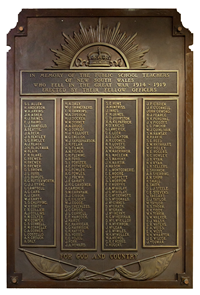 This honour board of public school teachers who fell in the Great War 1914-1919 resides in the Department of Education and Communities' historic Bridge Street office. |
|
As you look for a veteran to research you may find some communities were more affected than others. 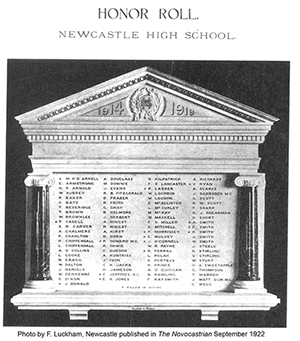 ©Register of War Memorials in NSW In New South Wales, First World War recruits from a local area often served in the same battalions. This regionalisation sometimes had significant community consequences in terms of battle casualties. For example, the 35th Battalion of the 9th Brigade, 3rd Australian Division, was formed from mostly Newcastle recruits. This battalion was decimated in the battle at Passchendaele where 418 of the 508 servicemen were wounded or killed. The same surname on community memorials may indicate a number of enlistments or casualties from the same family. |
|
How can their full name and service number be identified?
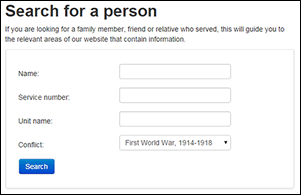
Image of search window on the Australian War Memorial website.
The purpose of this search is to identify the veteran’s full name and service number or officer rank and some distinguishing personal details, such as age and next of kin.
Search for a veteran on the People tab at the Australian War Memorial:
-
enter your veteran’s surname, followed by their first initial or their Christian name and surname in ‘Search for a person’
-
select ‘Conflict: First World War, 1914-1918’ from the drop-down menu
-
click on ‘Search’
-
scroll down to ‘Search results’ for all results of this search
-
review the records found.
Select the ‘View digitised record’ to access the record archives from the First World War.

Perform an initial search for Frederick Brightfield.
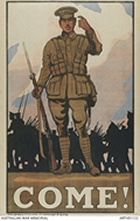
Recruitment poster, ca 1915. Public domain, Australian War Memorial.
The National Archives of Australia holds the personnel dossiers and service records for those who served in the first AIF.
The process below models how to find a specific service record or personal dossier.
-
select ‘The Collection’ > ‘Popular research topics’
-
select ‘Defence’ > ‘Service records’
-
select ‘Army – World War I’
-
scroll down to ‘NameSearch’ to access the ‘RecordSearch’ option.
-
for a basic search use the veteran’s surname and the date from 1914 to 1920
-
if the basic search returns a large number of results use the ‘Advanced search’ tab
-
review results using given names and service number.
Cross-reference with details already known to confirm the veteran’s identity.
Alternatively Mapping our Anzacs could be used.

Search for Frederick Brightfield’s service record.
Before you begin
Identifying, researching and adopting a First World War veteran is a complex research process that uses archival records held at different locations. These records are now 100 years old and many are incomplete.
Be aware that some information and archival images may be confronting or distressing. You are encouraged to seek appropriate support should this occur.
Read about Researching Australian military service: First World War, 1914-1918 at the Australian War Memorial.
Identify a veteran
There are various ways you can choose a veteran to research, they may have personal or family significance, be from a story you are familiar with, or a name from a war memorial.
Honour Boards and Memorials were community initiatives, and record the names of men from the local area. A variety of icons were used to denote if the men were injured or killed. Referencing First World War Honour Boards and War Memorials can help to establish some initial information, such as place, spelling of name and dates to assist in verify the identity of your selected AIF veteran.
Honour Boards and War Memorials may not provide a comprehensive of list of service personnel, as they may only record the names of those who were killed or cover a limited time period during the war. At times local names may have been left off, such as if the veteran was Aboriginal or a female nurse.
The Australian War Memorial provides information about researching names on an honour board.
An intriguing or mysterious source can also prompt historical research. Engaging with First World War personal sources such as letters or diaries can provide inspiration when identifying a veteran to research. The Australian War Memorial and the State Library of NSW both hold extensive collections of personal letters and diaries. Search the War Memorial’s People Profiles and biographies page and Life Interrupted: Personal Diaries from World War I at the State Library of NSW. These online catalogues allow for detailed search functions to be done.
Initial search
The first steps in the research process are to clearly identify the veteran’s full name and service number, which is their individual Australian Imperial Force reference number. This step can be time consuming and sometimes challenging to clearly identify the single veteran you wish to investigate as there may a number of complications, including veterans with the same name, to work through.
Cross reference these search results and compare to the personal information already collected. Once information such as service number, date of enlistment, battalion and, if possible the company, are found then further details can be more easily located.
Starting with a name
The Australian War Memorial’s search function under the ‘People’ tab accesses several different sources. It is important to select First World War 1914-1918 from the ‘Conflict’ drop-down menu.
The results of the search from each database are listed under the search function. Results will vary according to the records available for the person you are researching.
It may be necessary to review this initial information with reference to the personal information you may already have, such as the location or place i.e. town or suburb, names of next of kin and place of birth, with the evidence found in the records.
The Australian War Memorial web page Detailed Description of First World War Embarkation Roll explains the information contained in the embarkation rolls.
There are a large number of responses for the name I am using. How do I narrow the search down?
How do I know when I have found the person I want to research?
Where a large number of responses are provided for a name common at the time, it becomes necessary to use information that is already known, such as rank, location or awards to narrow down the possibilities. Search the Embarkation Roll for each name which further narrows the search to a short list. Use known details to identify the specific individual you are researching.
If the name has been selected from a local war memorial then this also provides a location where the veteran may have been born or lived; however, initials may only be used instead of the given name. Rank and whether the person was killed, wounded or held as a prisoner of war may also be indicated by an icon beside the name.
Note that embarkation rolls are not complete. If a roll is not available then Search the First World War Nominal Roll instead.
Service records
Where can I find the veterans personal service records? What information do they contain?
Once the veteran(s) has been identified the next step is to find their personal dossiers, also commonly known as service records. A range of information will be contained in these records, which will be scanned originals.
These records usually contain:
Attestation paper – this is the name of the enlistment form completed by the person and usually has next of kin, employment details, marital status, age and place of birth as well as a physical description.
Note that no record of race or background was required other than the statement about where they were born such as ‘natural born’ which indicated that they had been born in Australia, or alternatively the name of the country in which they were born.
This attestation paper will also note which battalion and often the company they were placed in. This is important information to have as it supports further investigation. This will be followed by a ledger that shows where and when they travelled, any injuries and where they were treated, any missing reports and recommendations, such as:
-
Service and casualty form – also known as ‘Form B103’ which shows deployment, injuries and hospitalisation dates and locations.
-
Military correspondence – any communication between the Department of Defence and the person’s next of kin, and could include information about injuries or death, medals, promotions and questions about their location.
Service records are often hand written and also contain abbreviations, which can make them difficult to read. See the Australian War Memorial Glossary and the National Archives of Australia list of abbreviations for assistance.
Read these National Archives of Australia pages for more information: Fact sheet about World War I service records and Service records - Army – World War I: 1914-18.
These personal records do not provide specific information about what the person was involved in during the war. To find this information you will now need to access the Australian Imperial Force Unit War Diaries at the Australian War Memorial.

